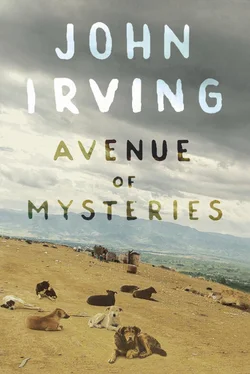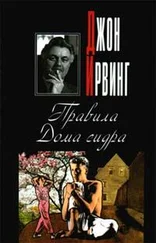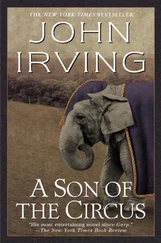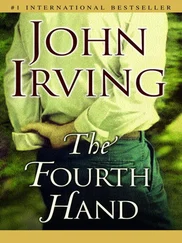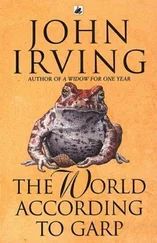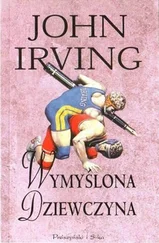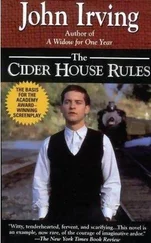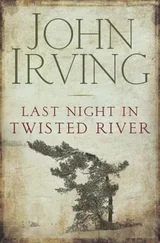“I wasn’t flirting,” Flor had insisted. Later, Juan Diego would think that these accusations concerning Flor’s flirtation with the young Mennonite cowboy in the clinic came the closest to recriminations that Edward Bonshaw would ever make about Flor’s return trips to Oaxaca — and what one could only imagine were the nature of Flor’s flirtations there.
Of course, and not only because she was pretty, this was when Juan Diego made friends with Rosemary Stein. She was Señor Eduardo’s doctor, and Flor’s doctor. Why wouldn’t Dr. Rosemary become Juan Diego’s doctor, too?
Flor told Juan Diego that he should ask Dr. Rosemary to marry him, but Juan Diego would ask her to be his doctor first. It would be embarrassing to Juan Diego to remember, later, that his first visit to Dr. Stein’s office as a patient was driven by his imagination. He wasn’t sick; there was nothing the matter with him. But Juan Diego’s exposure to seeing those AIDS-associated, opportunistic illnesses had convinced him that he should be tested for HIV.
Dr. Stein assured him that he’d done nothing to contract the virus. Juan Diego had some difficulty remembering when he’d last had sex — he couldn’t even be sure about the year —but he knew it was with a woman and he’d used a condom.
“And you’re not an intravenous drug user?” Dr. Rosemary had asked him.
“No — never!”
Yet he’d imagined the white plaques of Candida encroaching on his teeth. (Juan Diego admitted to Rosemary that he’d woken up at night and peered into his mouth and looked down his throat with a handheld mirror and a flashlight.) In the Virology Clinic, Juan Diego had heard about those patients with cryptococcal meningitis. Dr. Abraham told him the meningitis was diagnosed by a lumbar puncture — it presented with fever and headache and confusion.
Juan Diego dreamed of these things incessantly; he woke up at night with the fully imagined symptoms. “Let Mrs. Dodge take Flor and Edward to the clinic. That’s why I found her for you — let Mrs. Dodge do it,” Dr. Stein said to Juan Diego. “You’re the one with an imagination — you’re a writer, aren’t you?” Dr. Rosemary had asked him. “Your imagination isn’t a water faucet; you can’t turn it off at the end of the day, when you stop writing. Your imagination just keeps going, doesn’t it?” Rosemary asked.
He should have asked her to marry him then, before someone else asked her. But by the time Juan Diego finally knew he should ask Rosemary to marry him, she’d already said yes to someone else.
If Flor had been alive, Juan Diego could hear what she would have told him. “Shit, you’re slow — I always forget how slow you are,” Flor would have said. (It would have been just like Flor to mention his dog-paddling.)
In the end, Dr. Abraham and Dr. Jack would experiment with sublingual morphine versus morphine elixir — Edward Bonshaw and Flor were willing guinea pigs. But, by then, Juan Diego was letting Mrs. Dodge do everything; he’d listened to Dr. Rosemary and yielded the nursing to the nurse.
It would soon be 1991; both Juan Diego and Rosemary would be thirty-five when Flor and Señor Eduardo died — Flor first, Edward Bonshaw following her in just a few days.
That area of Melrose Avenue would keep changing; those over-the-top, extravagant Victorian houses with the grand front porches had already begun to disappear. Like Flor, Juan Diego had once loved the view of the Gothic tower from the front porch of that wooden house on Melrose, but what was there to love about that old tower after you’d seen the Virology Clinic on the first floor of the Boyd Tower building — after you’d seen what was going on below that tower?
LONG BEFORE THE AIDS epidemic, when Juan Diego was in his high school years, he was starting to feel slightly less enthusiasm for his Melrose Avenue neighborhood in Iowa City. For a limper, for example, West High was a long walk west on Melrose; it was more than a mile and a half. And just past the golf course, near the intersection with Mormon Trek Boulevard, there was a bad dog. There were also bullies at the high school. They weren’t the sort of bullies Flor had told him to expect. Juan Diego was a black-haired, brown-skinned, Mexican-looking boy; yet racist types weren’t very prevalent in Iowa City — they were represented (in small numbers, in a few incidences) at West High, but they weren’t the worst of the bullies Juan Diego would be exposed to there.
Mostly, the juvenile slings and arrows aimed at Juan Diego were about Flor and Señor Eduardo — his not-a-real-woman mother and his “fag” father. “A couple of queer lovebirds,” one kid at West High had called Juan Diego’s adoptive parents. The boy baiting him was blond, with a pink face; Juan Diego didn’t know the kid’s name.
So the lion’s share of the bigotry Juan Diego would be exposed to was sexual, not racial, but he didn’t dare tell Flor or Edward Bonshaw about it. When the lovebirds could discern that Juan Diego was troubled, when Flor and Señor Eduardo would ask what was bothering him, Juan Diego didn’t want them to know that they were the problem. It was easier to say he’d had some anti-Mexican stuff to deal with — one of those south-of-the-border insinuations, or an outright slur of the kind Flor had warned him about.
As for the long limp to and from West High — all along Melrose — Juan Diego didn’t complain. It would have been worse to have Flor drive him; her dropping him off and picking him up would have inspired more sexual bullying. Besides, Juan Diego was already a grind in his high school years; he was one of those nonstop students with downcast eyes — a silent male who stoically endured high school, but who had every intention of thriving in his university years, which he did. (When a dump reader’s only job is going to school, he can be reasonably happy, not to mention successful.)
And Juan Diego didn’t drive — he never would. His right foot was at an awkward angle for stepping on the gas or the brake. Juan Diego would get his driving permit, but the first time he tried driving, with Flor beside him in the passenger seat — Flor was the only licensed driver in the family; Edward Bonshaw refused to drive — Juan Diego had managed to step on both the brake and the accelerator at the same time. (This was natural to do if your right foot was pointed toward two o’clock.)
“That’s it — we’re done,” Flor had told him. “Now there are two nondrivers in our family.”
And, of course, there’d been a kid or two at West High who thought it was intolerable that Juan Diego didn’t have a driver’s license; the not-driving part was more isolating than the limp or the Mexican-looking factor. His not being a driver marked Juan Diego as queer —queer in the same way that some of the kids at West High had identified Juan Diego’s adoptive parents.
“Does your mom, or whatever she calls herself, shave? I mean her face — her fucking upper lip,” the blond, pink-faced kid had said to Juan Diego.
Flor had the softest-looking trace of a mustache — not that this was the most masculine-looking thing about Flor, but it was apparent. In high school, most teenagers don’t want to stand out; they don’t want their parents to stand out, either. But, to his credit, Juan Diego was never embarrassed by Señor Eduardo and Flor. “It’s the best the hormones can do. You may have noticed that her breasts are pretty small. That’s the hormones, too — there’s a limit to what the estrogens can accomplish. That’s what I know,” Juan Diego told the blond boy.
The pink-faced kid wasn’t expecting the frankness of Juan Diego’s reply. It seemed that Juan Diego had won the moment, but bullies don’t take losing well.
Читать дальше
